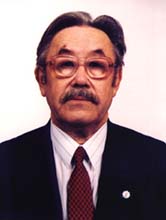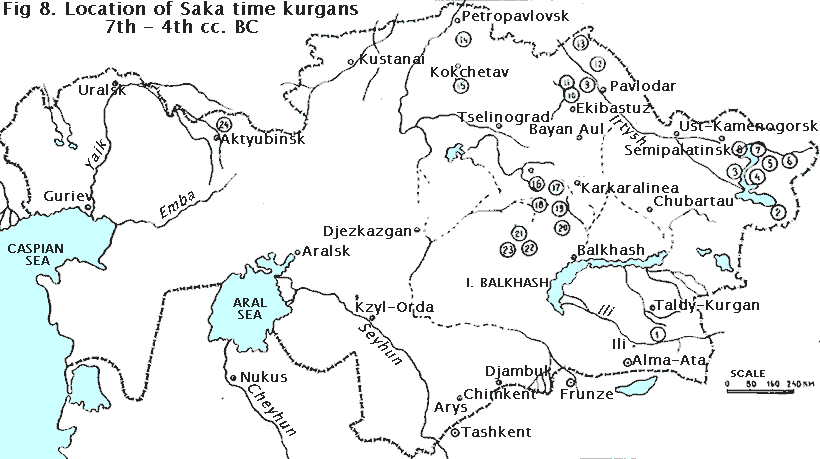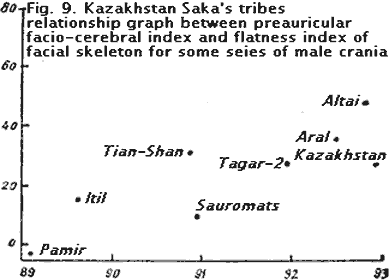|
||||||||
|
||||||||
Chapter 2 |
||||||||
|
During Early Iron Epoch in Kazakhstan was a Saka's tribes Culture. It can conditionally be divided into two periods, Saka's (7th-4th centuries BC) and Üsün (3rd century BC-4th c. AD). Sakas and Üsüns make a uniform ethno-cultural community, and are differentiated only during different periods of the Saka tribes existence (Voevodsky, Gryaznov, 1938; Bernshtam, 1952; Tolstov, 1960, 1963; Akishev, Kushaev, 1963). Therefore it is expedient to analyze them separately by the periods, to obtain a more precise percept about the change of anthropological composition at different stages of their race-genetic developments. The monuments of the 7th-4th centuries BC (Saka time) are mainly limited to kurgan burials. The sizes of the Saka Culture kurgans are very different, sometimes they have diameter more than 100 m and height about 20 m. The kurgans of Vesshatyr necropolis in the valley of r. Ili are just that big (Akishev, Kushaev, 1963). Most widespread are kurgans of medium sizes,
built of stone, and kurgans also were earthen and gravel
filled. Kurgans of 7th-4th centuries BC (Saka time) also vary in
design. In this regard are notable so-called kurgans with stone
arranged as "moustache", widely distributed in Central Kazakhstan.
These distinguished structures continued to be erected during the
3rd c. BC - 4th c. AD (Üsün time)
also (Kadyrbaev, 1959, 1962, 1966). Studies of burials of the Saka period tribes has shown that the diseased were buried in a pit grave (Central Kazakhstan) or in stone box (Jeti-Su), not frequently in a timber grave (Jeti-Su) in supine position, frequently west, sometimes with head to the north and northwest (i.e facing the rising Sun at the time of the burial). The funeral inventory is not too rich, but expressive. It includes arrow tips, horse bits, and other art objects in so-called (Scythian) animal style. Generally, in an economic - cultural relation the tribes of Saka Culture in the Kazakhstan have much in common with the synchronous tribes of Southern Siberia, Altai and Central Asia (unfortunately, these Türkic territories are presently in the administrative division of the Russian Federation, and because of the political borders, this study does not include the neighboring "common synchronous tribes"). The paleoanthropological material of the 7th-4th centuries BC (Saka time) is much less numerous than the archeological material. The skulls from the basin of the r. Nura (Central Kazakhstan) were investigated by G.F.Debets (1948), who concluded that they belonged to representatives of Andronov variety. Two more male and two female skulls from the same district belonging to them (i.e Andronovans) were described by V.V.Ginzburg (1956). A few skeletons of the 7th-4th centuries BC (Saka time) came from the Eastern Kazakhstan territory. In 1910, V.I.Kamensky found three male and one female skulls. In opinion of G.F.Debets (1948), for the male skulls are characteristic Andronovan features, and for the female skulls are characteristic some Mongoloid attributes (this is an amazing achievement of Soviet craniology called exaltingly "Anthropology". The Saka families exercised an art of producing Caucasoid sons and Mongoloid daughters. While the state doctrine talks about co-ed Mongoloid invasions, the science can only come up with the female line of invaders. Click here for overview of this "science"). We additionally measured these skulls for some attributes not included at the time of the G.F.Debets's program. S.S.Tchernikov's long-term excavation in Eastern Kazakhstan gave a small number of 7th-4th centuries BC (Saka time) skeletons. These materials (8 male and 6 female skulls) were described by V.V.Ginzburg. He attributed most of the skulls to Andronov type, and for some people he has noted an insignificant admixture of Mongoloid race. Similar morphological features have the skulls found in the northeastern part of the (Kazakhstan) republic (Ginzburg, 1961 a, 1961 b, 1963). This listing exhausts published materials about 7th-4th centuries BC (Saka time) anthropology in Kazakhstan. New paleoanthropological material for that time is
small, only 19 skulls (13 male and 6 female).
Most of them come from particular type of the Central
Kazakhstan monuments, the so-called "moustache" kurgans (Ismagulov, 1970). The skulls
we investigated were
collected by K.A.Akishev (1963) in Jeti-Su, F. Kh. Arslanova
(1964) in Irtysh area near Pavlodar, and M.K.Kadyrbaev (1966)
in the Central Kazakhstan.
Unfortunately, the state of the skeletons furnished by them
was very bad. Only after restorative work some of them
became suitable for anthropological research. [Follows a
detailed description of individual kurgan necropolises and
skulls] Individual description of skulls also shows that the anthropological type of Tasmolin Culture tribes included a Mongoloid admixture. The influence of Mongoloid gene on the local Caucasoid population has been also noted in other series of skulls of that time (Debets, 1948; Ginzburg, 1961). Some local distinctions between separate territorial groups of the Saka tribes are clearly pronounced. Regrettably, the majority of compared series is smallish. However, the difference between the Central Kazakhstan and East Kazakhstan groups is obvious. The East Kazakhstan groups have wide face, flattish face skeleton, weak protrusion of nose. These attributes tell about significant admixture of Mongoloids in the Ust-Bukon groups. The skulls from Northern Kazakhstan have Mongoloid features expressed even more distinctly than in Ust-Bukon series. However, because of a small number of skulls from the Northern Kazakhstan we do not have a complete confidence in the observations. Nevertheless, the Mongoloid admixture in anthropological composition of the Saka tribes does not raise any doubts. Thus, the tribes of 7th-4th centuries BC (Saka time) in anthropological relation were not homogeneous. But nevertheless a prevailing component during the that period was an ancient Kazakhstan Caucasoid type and forms close to it. In summary, the paleoanthropological material of the 7th-4th centuries BC (Saka time) in Kazakhstan accumulated 60 skulls (38 male and 22 female), including those studied by G.F.Debets, V.V.Ginzburg and the author. Fig. 8 Locations of the 7th-4th centuries BC (Saka time) burials where skulls were collected are shown on the map (Fig. 8).
The available material is enough to formulate a general concept about the physical type of the population of the Saka Epoch, and to observe similarity and distinction in the population of Kazakhstan and adjacent areas. Let's review the summary data for the skulls of the 7th-4th centuries BC (Saka time). The average values for a composite group of male skulls are characteristic medium longitudinal diameter, above average across dimension, and hence, a brachicranial type cranial index (81,3), fairly low shell of the cranium (131,3 from bazion), wide (99,2) and below average inclined forehead, above average nose bridge and supraorbital ridges; average height (71,7), but wide facial skeleton (138,6), average upper face (51,5) and vertical facio-cerebral (54,0) indexes, smaller zigo-maxyllar (130,5) and average naso-mallar (141,8) angles, lower average depth fang sockets; significant protrusion of nasal bones (nose angle 30,2; dacryal height - 12,6; symotic height - 4,6) and the average nasal index (50,2); low (33,2), but wide orbits (40,7). In the female skull series the cranial is low (125,6 from bazion),
brachicranial type (cranial index 80,9), with average-wide
(93,6), but a sloping forehead (82,2), below average
nose bridge and supraorbital ridges. The facial skeleton in
height and width belongs to large sizes (malar
width129,6, height of face 70,0); zigo-maxyllar
and naso-mallar angles are close to small and average sizes (<zm ' 130,4; <fmî
140,7); fang socket average depth;
the angle of nose protrusion is above average (24,5); the
height dimension of nose bridge approach large values (dacryal height 11,8, symotic height
4,3); nose of average width and heights, mezorinian by its index (49,8); orbits
are average-high (34,0), but because they
are wide, they are low orbit by the index (from d 39,6). Generally, the skulls of 7th-4th centuries BC (Saka time) are characterized by average longitudinal and across dimensions, brachicranial and fairly low shell of the cranium, wide forehead with averagely expressed nose bridge and supraorbital ridges, average height, but wide face, well profiled in a horizontal plane, with sharply protruding nose, low and wide orbits. These attributes allow us to confidently state
that the base of the physical shape of tribes in question
is the ancient Kazakhstan (Andronov) type, widely spread
in the Kazakhstan territory still in the 17th-8th
centuries BC (Bronze Epoch). Hence,
the Kazakhstan inhabitants of the 7th-4th centuries BC
(Saka time) were direct descendants of
the ancient local population
that had, as is known, sharply expressed Caucasoid features. The continuity
is also supported by
numerous data of the material culture of that time. However, there
are also some special morphological features in the anthropological
type of the population of that epoch. So, the skulls from
the kurgan burials of Saka Culture, in comparison with the
skulls of the
previous period, have higher and wider face, less
protruding nose and smaller height of a nose
bridge, lower cranium, and a number of other features which are found out
not only in the descriptive dimensions, but also in average
dimensions. These shifts in the physical type of the
Kazakhstan Sakas, probably, are connected with the penetration of
Mongoloid groups. A detection of Mongoloid
admixture in the Saka population of Kazakhstan is not
a new development, it was repeatedly noted by G.F.Debets (1948)
and V.V.Ginzburg (1956, 1961, 1963). Next should be determined the Mongoloid components that fed into the anthropological composition of Sakas, their ratios, and also the time and ways of their penetration in the territory of Kazakhstan. Now, unfortunately, to resolve these and other important ethnogenetical questions not enough materials are available. Therefore we will limit ourselves only to the suggestions about the race-genesis of the Saka's tribes (in 1800-1970es the word "race" was not a dirty word in science yet, and in Russia today these racial concepts are not only energetically pursued, but also vigorously defended). Comparing the Kazakhstan Sakas with the synchronous tribes of adjacent areas (Table 4) (not cited), it is possible to notice, that they find a closest morphological similarity, on one hand, with the Sakas of the Aral area (Yancai, or Alans of Chinese records) investigated by T.A.Trofimova (1963) and, on another hand with the Altai "Scythians" (so called Aldy-bel Culture, the early Scythians) investigated by V.P.Alekseev (1958). However, in our series the width of the face is much larger than for Aral area Saka (Alan) skulls, but a little less than for Altai "Scythian" (Aldy-bel Culture) skulls. By this attribute our series occupy an obviously intermediate position. The same can be also said about the height dimensions of the face. By the height of a crania the investigated series also occupy a middle place. As to distinctions, they exibit mainly in inclination of forehead and protrusion of nose. So, the nose angle is more expressed for Kazakhstan Sakas. In contrast with the "Scythians" of Altai, and especially Aral area Sakas, in our series of skulls the forehead was very sloping. As a whole, despite of these and some other differences, all three groups, essentially, are descendants of the ancient steppe type people. Their commonality is still very obvious during the 7th-4th centuries BC (Saka time). It should be noted that probably they absorbed the same Mongoloid components. However between the Kazakhstan Sakas the Asian features are expressed a little weaker than for the Aral area Sakas (Alans) and "Scythians" of Altai. The last two groups in the strength of Mongoloid elements seem to be closer between themselves. From material abpve can be concluded that the territory of Kazakhstan during the 7th-4th centuries BC (Saka time) was already in the zone of a mestization. But the Mongoloid admixture during that period was still insignificant in the mass of the local Caucasoid population. Not one craniological series shown in the table does not
differ so sharply from our series as the Saka series
of Southern Pamir, investigated by V.V.Ginzburg (1960). The
Saka series of Southern Pamir has a high cranial,
dolichocranial type. A face skeleton is very narrow, high
and sharply profiled in a horizontal plane, a nose strongly
protruding. Many Soviet researchers repeatedly wrote about
anthropological features of the Pamir Sakas, and their
difference from the Sakas of Khoresm, Tian-Shan and
Kazakhstan, and classified them as representatives of Indo-Pamirian
type, Eastern Branch of the Mediterranean race
(here the term Pamir Sakas is as
justified as would be a Saharan Eskimo, coined by a
powerful Eskimo nation who conquered the lands down to
Egypt, and wanted to prove its racial continuity. The
"Pamir Sakas" not only were genetically different, but also
culturally different, they did not built kurgans, as did
all other Saka tribes, and to call them "Saka" is a
deliberate antic). The skulls of Tagar Culture (II stage), investigated by V.P.Alekseev (1961), are morphologically closer to the skulls of the Saka Culture of Kazakhstan, and differ from them only by a smaller cranial index, higher cranial, more upright forehead, and some other traits. As for the main linear dimensions of the face skeleton, they are close between themselves, which probably is connected with the anthropological features of the initial proto-Caucasoid forms. Comparison of the studied series with the series of Sauromat skulls from the Lower Itil region (Firshtein, 1961) exhibit distinctions in many traits. So, the Kazakhstan skulls have more expressed brachicrania, lower cranium, relatively higher and less protruding nose. Generally, in our series the Caucasoid features are weaker. At last, the skulls of the Saka Culture were compared with the series of , studied by G.F.Debets. It turned out that the Dniepr basin Scythian skulls differ from the Kazakhstan Sakas mainly in the linear sizes of the crania and facial skeleton (the high crania, dolichocranial type, significantly narrow and upright forehead, narrower and more profiled face, more protruding nose and lower orbits). The Mongoloid traces in the physical appearance of the 7th-4th centuries BC (Saka time) tribes in Kazakhstan are more pronounced.. The comparative characteristic of the Kazakhstan Saka's tribes is complemented by a relationship graph between preauricular facio-cerebral index and flatness index of facial skeleton (Fig. 9). This combined method was offered by G.F.Debets (1964, 1968) to differentiate the Caucasoid and Mongoloid groups (A curious reader should ensure that he enjoyed the substance, scientific depth, and significance of the Debets' "Mongoloidness Index". It is too minacious and portentous to be reduced to a brief vile comment). Fig. 9. Kazakhstan Saka's tribes
The analyzed data shows that in the anthropological base of
the Saka tribes in Kazakhstan
mainly lays the physical type of local Andronov culture
population, which by the studied period had already absorbed elements of
the Mongoloid race. Hence,
the process of a mestization within local inhabitants of
the Kazakhstan began not later then the Saka time
(7th-4th centuries BC). However
it is known that in
the Central (i.e. Middle) Asia and Kazakhstan
territory until recently
some researchers connected the occurrence of
the first Mongoloid type with the penetration of the Huns
(Bernshtam, 1940, 1949; Ginsburg, 1951, 1954)
(actually, it was, and still is,
an axiomatic and encyclopedic doctrine of Indo-Europeistics
in general, and Russian "PC science" in particular).
The materials
of later years (i.e. pre-1970es) have shown
that process of mestization among
natives had occurred before the invasion of the Huns to Central Asia
and Kazakhstan (Debets, 1956; Trofimova, 1963). A majority of the Soviet anthropologists
quite rightly connect the appearance of Mongoloid
component among the Saka tribes with Central Asia. In
opinion of some researchers, Mongoloid groups penetrated territory of
Middle Asia and Kazakhstan from Altai (Trofimova, 1963; Ginzburg, 1961; Alexeys,
1961). That hypothesis is also supported archeologically.
The Central Asian tribes probably were moving west not only
via Altai, but also through other,
adjacent with Middle Asia and Kazakhstan areas that had necessary conditions for nomadic life. Such
a convenient area was the Djungarian Gates area, to which
historical role in the destiny of Middle Asian peoples
ascribed the
greatest orientalist and a first researcher of that
territory Ch. Ch.Valihanov. He wrote that in Djungaria
"stopped and settled all tribes
that emigrated from high Gobi" (Valihanov, 1961). These
statements of Ch. Ch.Valihanov do not contradict the modern archeology and
anthropology. Therefore is not excluded a possibility of Mongoloid groups
penetration into the Middle Asia also through Djungarian Gates.
Thus, the infiltration of the Central Asian groups to
Middle Asia and Kazakhstan, probably, went not only
through Altai, but also through Djungaria. Finally, the paleoanthropological
study of 7th-4th centuries BC (Saka time)'s skulls lead to the conclusion, on the one hand, about
early close anthropological connections of
local (Andronovo-type) population with Mongoloid groups,
and on another hand, about assimilation of the newcomer groups with the
aboriginal inhabitants of the country, which started a mestization of the ancient Caucasoid population in Kazakhstan
beginning in the second half of the 1st millennium B.C. |


